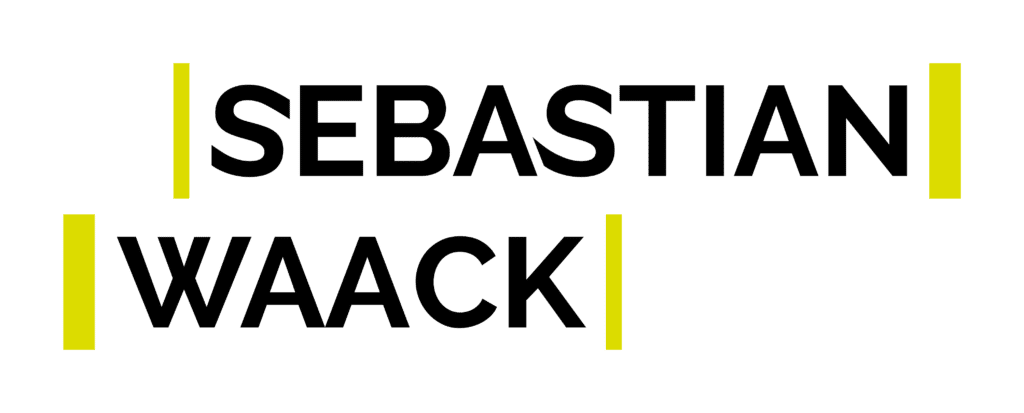More turnover. More profit. More time.
Process optimization in scaffolding construction
Do you know the problems too?
- Delays in erecting and dismantling scaffolding.
- Difficulty in coordinating personnel & materials.
- Lack of documentation leads to loss of material and time.
Stay relaxed. I have a solution.
Finally more success:
Process optimization
is your key for
better operations
Nice to have you back
Let's together
on your problems
work.
Scaffolders often face complexity. Processes are simplified with targeted workflows and modern digitization. Maximize your profits and minimize stress. Sebastian Waack optimizes your scaffolding business.
Scaffolding is challenging. Lack of coordination, poor documentation and unforeseen delays cost time and money.
This is where process optimization comes into play. Sebastian Waack understands the intricacies of the scaffolding trade. It offers solutions in employee development, digitization and quality management.
Imagine a smooth operational flow where every project is completed on time and within budget.
Fewer headaches, more satisfaction.
Are you ready for change?

Work Results:
Sebastian Waack supported a northern German scaffolding company in significantly optimizing their erection and dismantling times through process documentation and training.
Thanks to Sebastian’s digitization strategies, a Berlin-based scaffolding team has significantly improved their material and personnel planning and greatly reduced overlaps.
Thanks to Sebastian’s documentation solutions, a scaffolding company in Bremen minimized their material loss and noticeably increased project efficiency.
- Process documentation
- Digitization
- Inventory Management
- Employee development
- Quality management
Solution 1

Delays cost money and are bad for the image. Sebastian Waack helps to make the assembly and disassembly faster.
It specifies exactly how everything is done. With training, employees learn how to do it. An app shows where things are going too slowly. Then you can help there in a targeted way.
Sebastian also keeps checking in to see how things are going and helps with any problems. There are fewer delays that way. Everything runs like a well-set alarm clock.
Delays are expensive and damage reputations. Sebastian Waack uses process documentation to standardize set-up and dismantling procedures.
Each step is precisely defined. In conjunction with regular employee training, these processes are internalized. Digitization can also provide support.
For example, a time tracking app for construction projects shows which phases of construction and dismantling take the longest. This allows bottlenecks to be identified and training to be targeted.
Sebastian also provides regular check-ins to monitor progress and make adjustments. Through constant monitoring and improvement, delays are minimized and can often be avoided altogether. It’s like a clock that runs precisely and synchronously.
Solution 2

Coordination in scaffolding is super important. If something is missing or someone is not there, there are problems.
Sebastian’s digital tools make organizing easier. He has programs that show where the material is and warn when something is running low.
There are also programs that show who is working and who has time. It is also important that everyone knows what to do. Sebastian makes sure that everyone is well trained.
Through training, everyone knows what to do. This makes everything easier and faster.
Coordination is crucial in scaffolding. If just one component is missing or an employee is not available, everything comes to a standstill.
Coordination is facilitated by digital tools introduced by Sebastian Waack. It integrates systems that show the location of materials in real time and send automatic notifications when stocks run low.
In parallel, there are employee management tools that show the work status and availability of each team member. Another important aspect is training. Sebastian places great importance on all employees not only knowing their specific tasks, but also understanding the big picture.
Regular workshops and training sessions keep everyone up to date. These measures significantly reduce coordination problems and improve efficiency.
Solution 3

Good records in scaffolding are very important. They help not to lose anything and everyone knows what to do.
Sebastian Waack knows his stuff and has systems that are easy to use.
He has a program that records everything from purchase to final inspection. With a QR code, you can scan each part and see where it is and what it is used for.
Everyone on the team learns how to use the program. And Sebastian keeps checking to make sure everything is up to date. With this program, less is lost and everything runs faster because you don’t have to search for a long time.
Complete documentation is invaluable in scaffold erection. It prevents material loss and ensures that everyone knows what to do.
Sebastian Waack has experience in implementing documentation systems that are both robust and user-friendly.
It implements a system that captures every aspect of the scaffolding process, from material procurement to final inspection. For example, QR codes can be used to scan each component and record its use and location.
Training ensures that each team member understands and applies documentation practices. Regular checks and updates ensure that the system is always up to date. Such a system not only reduces losses, but also increases productivity, as less time is wasted searching for materials or information.
What do I mean by...
More details about the building blocks
Process documentation
Process documentation in scaffolding: precision meets efficiency. Every step clearly defined, every component in view. Future-proof building!
Quality management
Quality management in scaffolding: Highest standards, safe designs. Perfection in every detail. For construction projects that inspire.
Inventory Management
Inventory & supply chain management in scaffolding: Always the right part at hand. Increase efficiency, optimize construction sites. Every project in flux.
Digitization
Digitalization in scaffolding: modern construction with smart technology. Save time, minimize errors. The future of scaffolding starts now.
Employee development
Employee development in scaffolding: from craftsman to expert. Education and practice that strengthen each project. Invest in talent, build the future.
What is currently the biggest challenge in your scaffolding business?
I'm thinking... give me 5 seconds ...
Real case studies of my work as a process optmizer in the scaffolding trade
A scaffolding company from Hamburg was constantly struggling with project delays. This caused dissatisfaction among customers and thin profit margins. The main reason for these delays was a lack of coordination of materials and personnel. Parts were often missing or damaged, and employees were not always clear about their responsibilities. There was also no clear documentation of the work processes.
Sebastian Waack was brought in to identify the root causes of the problems. He noted that there were no clear channels of communication between the warehouse, site managers, and work teams. The warehouse often didn’t know which parts were needed for which projects, and the teams at the site had no way to accurately communicate their material needs. There was also no clear documentation of the condition and location of each scaffold component.
Sebastian suggested a two-pronged solution: Process documentation and digitization. First, clear processes were created for ordering, delivering and using materials. The process documentation included detailed steps for each team member to follow in preparing and executing projects. This documentation was compiled into an easily accessible manual that was available to all employees.
For digitization, Sebastian introduced a cloud-based management system. This system allowed site managers to communicate material needs in real time and warehouse staff to monitor material availability and reorder as needed. Each part of the scaffold was provided with a QR code so that its position and condition could be checked at any time.
Training was provided to the entire team to ensure they were comfortable with the new system and processes. Sebastian also held regular check-ins to monitor progress and make adjustments as needed.
After a few months, this approach showed impressive results. Project delays scaffolding company from Hamburg were significantly reduced, and customer satisfaction increased. Clear communication between teams and transparency of workflows resulted in more efficient operations and higher profit margins for the company.
A scaffolding company from Hamburg was constantly struggling with project delays. This caused dissatisfaction among customers and thin profit margins. The main reason for these delays was a lack of coordination of materials and personnel. Parts were often missing or damaged, and employees were not always clear about their responsibilities. There was also no clear documentation of the work processes.
Sebastian Waack was brought in to identify the root causes of the problems. He noted that there were no clear channels of communication between the warehouse, site managers, and work teams. The warehouse often didn’t know which parts were needed for which projects, and the teams at the site had no way to accurately communicate their material needs. There was also no clear documentation of the condition and location of each scaffold component.
Sebastian suggested a two-pronged solution: Process documentation and digitization. First, clear processes were created for ordering, delivering and using materials. The process documentation included detailed steps for each team member to follow in preparing and executing projects. This documentation was compiled into an easily accessible manual that was available to all employees.
For digitization, Sebastian introduced a cloud-based management system. This system allowed site managers to communicate material needs in real time and warehouse staff to monitor material availability and reorder as needed. Each part of the scaffold was provided with a QR code so that its position and condition could be checked at any time.
Training was provided to the entire team to ensure they were comfortable with the new system and processes. Sebastian also held regular check-ins to monitor progress and make adjustments as needed.
After a few months, this approach showed impressive results. Project delays scaffolding company from Hamburg were significantly reduced, and customer satisfaction increased. Clear communication between teams and transparency of workflows resulted in more efficient operations and higher profit margins for the company.
Contact: I am looking forward to your message

Your direct line to me.
I look forward to your message and will get back to you as soon as possible.
- Bremen & online via Zoom
- inquiry@sebastianwaack.de
- +49 (0) 176-414 862 64
FAQs
-
Process optimization in the scaffolding trade is the systematic review and improvement of work processes in order to achieve maximum efficiency and productivity. This can be done by applying lean management principles, automated solutions, improved communication processes and better resource management.
-
Safety is a critical aspect of the scaffolding trade. Process optimization can help to establish clear and efficient safety protocols, ensure compliance with standards such as DIN 4420 (working and protective scaffolding) and minimize the risks of accidents at work.
-
Yes, efficient process design can result in less time, resources and effort being required for tasks, which leads to a reduction in costs. In addition, improved processes can minimize downtimes and thus increase productivity.
-
Optimized processes enable scaffolding companies to better manage their resources. This can mean that materials are used more efficiently, stock levels are managed more accurately and the availability of labor is better planned.
-
Yes, optimized processes can help reduce project turnaround times by removing unnecessary steps and improving communication between teams.
-
Yes, by improving processes, scaffolding companies can deliver their projects on time and with better quality, which can improve customer satisfaction.
-
Digitalization is playing an increasingly important role in many industries, including scaffolding. Digital tools can help to automate processes, improve communication, facilitate documentation and make it easier to access important information.
-
Process optimization can help to establish clear and efficient workflows, which reduces the likelihood of errors. This can help to improve the quality of work and reduce costs and downtime.
-
Through more efficient processes and better resource management, process optimization can help to reduce material consumption and waste, which not only saves costs but also helps to comply with environmental regulations.
-
The first step is a thorough analysis of current processes and workflows. A process optimizer can help identify areas that can be improved and create a plan to implement these improvements.
-
The duration of process optimization can vary depending on the size and complexity of the operation. However, it is important to note that process optimization is an ongoing process that requires constant review and adjustment.
-
Employee involvement is a critical aspect of process optimization. This can be achieved through regular training, open communication and the involvement of employees in decision-making processes.
-
Process optimization can help to improve the efficiency and quality of work, reduce costs and increase customer satisfaction. All of this can help to improve the competitiveness of a scaffolding company.
-
Process optimization can help to establish clear communication channels and effective collaboration processes, which can improve team efficiency and satisfaction.
-
Yes, by helping to improve efficiency, reduce costs and increase customer satisfaction, process optimization can be an important factor in achieving your business goals.

